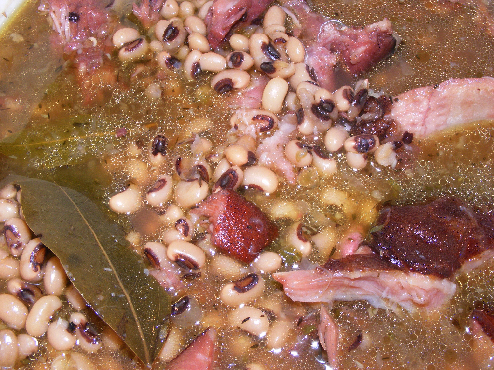Black Eyed Peas: Vietnamese Sweet Rice & Bean Pudding – Che Dau Trang
Wednesday, January 6th, 2010A lot of folks still make resolutions for the New Year. I’m one of them. This year I’ve vowed to be a better me in 2010. I’m calling it 3B: better, bolder and badder. To do it I’ve got to break away from what’s comfortable and lean toward that which makes me apprehensive. You know the things big and small where you silently say to yourself – maybe I shouldn’t, maybe I can’t or I won’t like it. In 2010, I aim to be open to the possibilities.
This recipe for sweet rice and beans is a step in that direction . . . it’s out of the ordinary for my palate but I was pleasantly surprised. When I was researching black eyed peas and the different cultural preparations for these legumes last month, my brows rose with curiosity when I first learned about che dau trang, a Vietnamese sweet rice and bean dish. See, when I eat Vietnamese, my lips smack for spicy lemongrass sauce, salty fish sauce, pho or bun. But since I’m working on my 3B, I resolved to at least try this sweet bean pudding. And, I’m glad I did.
Che (sweet dessert soups or puddings) is believed to have originated in the central region of Vietnam. Che dau (sweet bean dessert) is made in numerous variations, the name changing with the beans that are used – for example, mung (xanh), azuki (do), black (den) and white/black eyed peas (trang).
Sweet bean desserts are a popular snack food because of their hearty contents – beans and sticky rice. Typically, the black eyed pea version is a bit thicker and sets up like a rice pudding. Since they are also sweet and rich, they are definitely decadent enough to be considered a dessert. It’s usually enjoyed hot or chilled. Although it is also enjoyed in a tall glass over ice, eaten with a long spoon. An interesting cultural note from Anh, my Vietnamese friend’s momma, is that it is tradition to serve che dau trang when celebrating a baby’s one month birthday.
This is not just novelty fare. I was delighted with my first bite. The beans are cooked just right, not too firm or mushy, and are a nice contrast to the creamy coconut rice. I doubt I could eat but a spoonful after a meal, but I would enjoy this again as a tasty breakfast porridge or as the Vietnamese do – as a snack.
Tidbits on Black Eyed Peas
- Black eyed peas are believed to originally hail from Africa or India, and subsequently were grown in Asian countries. From there, they were introduced into the West Indies and to the American South around the 1600s.
- Black eyed peas provide a good source of calcium, folate, iron, potassium and fiber.
Source: AsiaRecipe.com (see Vietnam Food History), FoodReference.com, Encyclopedia of Food and History


 Eating black eyed peas on New Year’s Day is a longtime custom among African Americans and Southerners who believe the legumes will bring prosperity and good luck, especially when paired with greens, which symbolize money. Some folks say you just need to eat a spoonful and others say at least 365 (one for each day of the year). Regardless, this year, in this economy, the superstitious dare not skip this tradition.
Eating black eyed peas on New Year’s Day is a longtime custom among African Americans and Southerners who believe the legumes will bring prosperity and good luck, especially when paired with greens, which symbolize money. Some folks say you just need to eat a spoonful and others say at least 365 (one for each day of the year). Regardless, this year, in this economy, the superstitious dare not skip this tradition.



